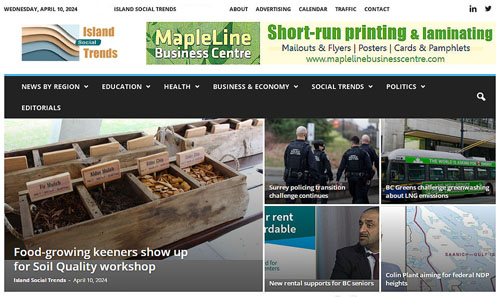Thursday April 11, 2024 | VICTORIA, BC [Updated April 12, 2024]
by Mary P Brooke | Island Social Trends
The BC Building Code was updated yesterday with a big change… with regard to the use of mass timber.
BC Housing Minister Ravi Kahlon announced that — effectively immediately — mass timber can be used to:
- Allow for 18 storeys (residential and office), up from 12 storeys
- Allow for up to 9 storeys without drywall.
- Allow for different building structures – like schools, libraries, retail, light- and medium-industrial occupancies, and care facilities.

The Vancouver Island Construction Association approves of the change but has some further comments.
“The Vancouver Island Construction Association supports the use of sustainable building technologies and practices to advance our collective goals of addressing the impacts construction has on our climate and the housing affordability crisis,” stated Rory Kulmala, CEO, Vancouver Island Construction Association (VICA).
“We believe that mass timber building technology has the potential to address both of these issues, while also supporting Vancouver Island’s forestry and manufacturing sectors,” says Kulmala.
VICA currently has nearly 500 members, according to VICA marketing and communications manager Owen O’Rourke.
No immediate effect on current projects:
“We applaud the Government of British Columbia’s changes to the building code to allow for mass timber projects to be built up to 18 storeys, however, we don’t anticipate that this announcement is going to have an immediate effect on projects already underway, or close to breaking ground,” he said.
Project viability & overall cost:
“Yesterday’s announcement will increase the viability of mass timber projects for some developers and owners, coupled with the lower price of wood,” according to VICA.
“The financial savings of using mass timber as a building material have yet to be fully established, primarily because the price of lumber has been at a historically high level since 2021, although prices have normalized recently,” says Kulmala.
“Additionally, the supply chain that supports mass timber has not been fully established.”
“That is not to say that there will not be a cost saving when using mass timber, however, despite today’s announcement, we are anticipating a lag in the adoption of mass timber for high-rise projects.”
Already in use:
The organization points out that some of their VICA members are actively working on mass timber projects, citing the Westshore Post-Secondary Campus at Goldstream Avenue and Peatt Road as an example.
“So the concept of using mass timber as a building material is not new to island contractors.”
No safety concerns:
According to VICA, in speaking to engineers within their membership, there is confidence in mass timber being used as building materials.
In May of last year, VICA Member RJC Engineers took part in a study that saw a 10-storey mass timber building built on the world’s largest “shake-table”, which simulated 6.7 and 7.7 earthquakes.
“From what we’ve read, the researchers found no structural damage following each test. For fire safety, tests have been completed with the results validating the fire safety performance of the material.”
“Similar to the earthquake tests, researchers constructed a mass timber building and then set it on fire, letting it burn without intervention to completely understand how the material would perform,” reports VICA.”
===== RELATED:
- Mass timber buildings can now be 18 storeys tall (April 10, 2024)
- Vancouver to host high-rise timber construction convention in 2025 (October 17, 2023)
- Tallwood 1 stands tall in Langford core (August 18, 2022)
- Post-secondary education expanding for students on the Westshore (August 3, 2022)
- BC launches forest bioeconomy collaboration with Finland (June 3, 2022)
- VICA aims to lead economic recovery through institutional, commercial & industrial construction (December 3, 2021)
- HOUSING NEWS by Island Social Trends










